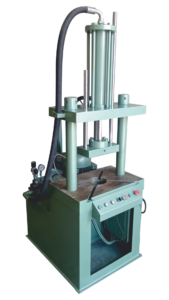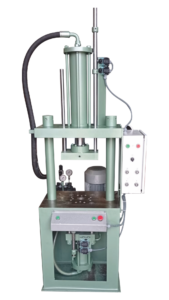Hydraulic Plastering and Crushing Presses
Hydraulic Plastering Presses are machines that shape metal sheets or sheet materials between molds under high pressure. This process allows metal parts to take the desired form.
Plastering presses are used in the production of complex and unique parts in industries such as automotive, electronics and white goods. Plastering presses offer advantages such as high precision, excellent quality, fast production and low cost.
The main features of plastering presses are as follows:
- Steel construction body
- PLC application and touch screen control unit
- T-slotted top and bottom table
- Adjustable stroke
- Dual hand control for operational safety
- Electric counter
- The technical details of plastering presses vary according to the type, capacity, size and hydraulic systems used.
- Capacity 10 – 500 Tons
- Cylinder diameter 100 – 500 mm
- Cylinder stroke 200 – 800 mm
- Table size 600×600 – 1250×1250 mm
- Opening height: 200 – 1000 mm
- Engine power 4 – 75 kW
Hydraulic system: Fixed or variable displacement pump, slide, poppet or logic valve, load or power sensitive control.
Hydraulic Plastering Presses play a critical role in many industries.
For example, in the automotive industry, they are widely used in the production of vehicle bodies and parts.
In the electronics industry, they are used in the production of metal cases and components.
In the white goods industry, it plays an important role in shaping the metal parts of products such as refrigerators, washing machines and dishwashers.
In the kitchenware industry, it is used in the production of products such as pots, pans and teapots from metal materials.Steel construction body.
Hydraulic crushing presses are machines used to crush, flatten or mold metal materials under high pressure. These machines play an important role in the production of different products in many sectors such as metal processing, automotive, defense, white goods and kitchenware.
Hydraulic crushing presses offer advantages such as high performance, low energy consumption, long life, easy maintenance and safe operation.
Hydraulic crushing presses can be of different types and capacities. For example, H Type, C Type, Column Type, Workshop Type. These types are separated according to features such as the structure, power, size, area of use of the press. Hydraulic crushing presses consist of components such as hydraulic systems, electrical panels, control units, cylinders, tables, valves, pumps. These components affect the working principle, speed, precision and safety of the press.
The main features of hydraulic crushing presses are as follows:
- Steel construction body
- PLC application and touch screen control unit
- T-slotted top and bottom table
- Adjustable stroke
- Dual hand control for operational safety
- Electric counter
The technical details of hydraulic crushing presses vary according to the type, capacity, size and hydraulic systems used.
- Capacity 10 – 500 tons
- Cylinder diameter 100 – 500 mm
- Cylinder stroke 200 – 800 mm
- Table size 600×600 – 1250×1250 mm
- Opening height: 200 – 1000 mm
- Engine power 4 – 75 kW
Hydraulic system: Fixed or variable displacement pump, slide, poppet or logic valve, load or power sensitive control.






